Luxury and Comfort in To-day’s Rail Transport
ROLLING STOCK - 7
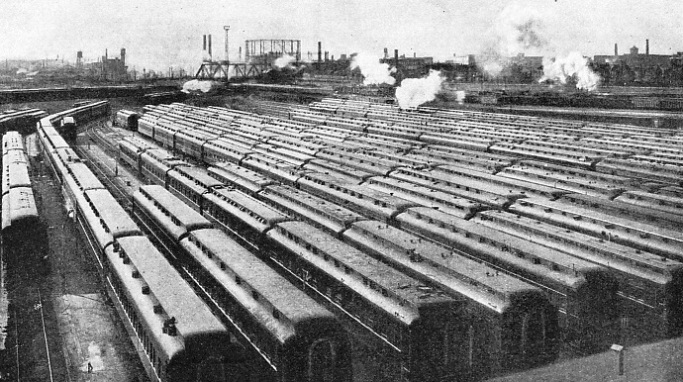
OVER 3,700 COACHES are owned by the Canadian National Railways. Modern Canadian rolling stock is of all-steel construction and there are many varieties of cars specially equipped for long transcontinental journeys. The types of CNR passenger rolling stock include colonist cars, observation cars, tourist coaches, and cars with private rooms for families or invalids. The above picture shows a large number of coaches waiting in one of the company's extensive sidings, to be made up into trains.
THERE are three-factors in the design of passenger rolling stock which rank as roughly equal in importance. From the passenger's point of view, comfort and smoothness of riding are the chief essentials, apart from speed, which is the province of the locomotive and operating departments, rather than of the carriage builder. From the locomotive and the operating point of view, however, seating capacity in proportion to the “tare”, or empty weight, of the stock is the vital matter.
Up to a point, these factors are antagonistic to one another. Increased comfort generally entails greater spaciousness; greater spaciousness means less seating accommodation in each compartment, and, therefore, more coach weight for each passenger conveyed. The tendency, therefore, for in this contest it is generally the passenger who wins, is for the weight of trains steadily to increase. And as the tendency is for train speeds to rise in the same progressive fashion, so the problem of train haulage incessantly becomes more onerous.
Every new amenity of travel that has been introduced has been at the expense of the locomotives. Corridors, first of all, have taken from coach width the equivalent of two seats in each compartment. Lavatories and end vestibules have deducted compartment space from coach-ends. The latest innovation of arm-rests in British third-class corridor compartments, on the LMS and LNE Railways, has at one stroke reduced their accommodation by 25 per cent. Indeed, whereas the previous standard 60 ft corridor coaches of the LNER had eight compartments and seated eight in each compartment, or sixty-four passengers in all, the newer coaches, with arm-rests in the compartments and more spacious lavatories, have seven compartments only and six seats in each, or a total of forty-two passengers. Thus the seating accommodation is reduced by over 34 per cent; or, alternatively, the tare weight per passenger conveyed is increased from 0.53 ton to 0.81 ton per passenger, that is, by 53 per cent, a serious increment from the haulage point of view.
Then the increasing popularity of the restaurant car means that, on many important express trains, two or even three coaches are given over entirely to the service of meals, and are not used at all for ordinary seating purposes. The “Royal Scot” of the LMS, for example, with separate restaurant car equipment in both its Glasgow and its Edinburgh sections, carries in summer two kitchen cars, two third-class restaurant cars, reserved exclusively for meals, and two half-sections of first-class cars similarly allocated. The equivalent of five complete coaches, weighing in all 150 tons, is thus devoted in this train to the service of luncheons and teas alone.
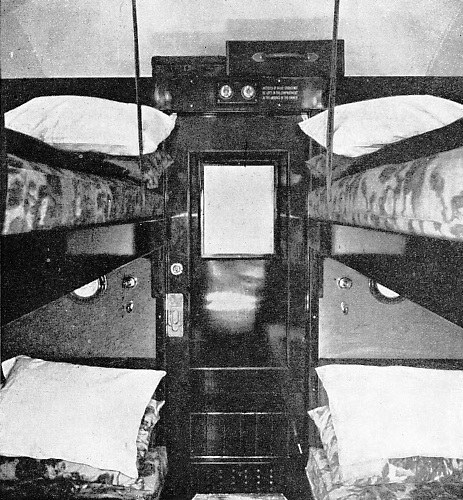
ON THE GREAT WESTERN and other British railways, four-berths third-class sleeping compartments are run on the principal night trains. First-class sleeping compartments on British railways contain only single bedrooms.
The same applies to the working of night trains, only to an intensified degree. A modern first-class sleeping car weighs 37 tons on the LNER, and 41 to 45 tons on the LMS; the former is carried on eight wheels and the latter on twelve. This gives a weight of roughly four tons of car to every passenger earned, for which it is doubtful it even the 20s. supplement paid by a passenger for a berth between London and Scotland is adequate compensation from the haulage point of view. The third-class sleeper, weighing 34 to 37 tons, generally has 28 berths, so that the weight to be hauled varies from 1.2 to 1.3 tons per passenger conveyed.
Not only so, but with the addition of various details to coach construction, such as steel panelling, reinforced ends, and more strongly built frames, the weights of the vehicles themselves have been steadily rising for years past. In 1905 the tare weight of a corridor coach 54 to 60 ft long was 25 to 27 tons or so; to-day the corresponding figure with all new stock is from 30 to 35 tons, though, in ways previously described, the seating accommodation has diminished rather than increased.
In the design of coaching stock for suburban working, however, the provision of maximum seating space in a minimum of length and tare weight is absolutely essential. Most of the suburban lines round London, for example, are crowded with trains to their utmost capacity. Further, as has been emphasized in more than one chapter of this work, the movement of traffic into and out of the City is largely confined to certain relatively brief periods of the morning and evening, known as the “rush hours”. Increasing the length of trains tends to slow down suburban working. The business of the designer of suburban stock is, therefore, while providing such comfort as is reasonably possible, to contain the seated passengers within the narrowest practicable limits.
It was the late Great Eastern Railway, serving the densely populated “dormitories” of North-East London, that first devised the idea of seating six passengers aside in the third-class compartments. Not only was new stock so built, but also, by an interesting surgical operation, many existing suburban coaches were split in two lengthways, and new pieces inserted down the centre, thus bringing these vehicles up to the requisite width for six-aside accommodation. Later on the original four-wheeled coach-bodies were mounted in pairs on new frames of double the length, and thus converted into bogie stock, for more comfortable riding. Now many of the LNER suburban trains into and out of Liverpool Street, and all those on the suburban lines of the Great Northern Section, are composed of articulated stock, to which further reference will be made in a moment.
At the peak periods the intensive Walthamstow, Chingford, and Enfield traffic, which is conducted, between Liverpool Street terminus and Bethnal Green Junction, entirely over one pair of tracks known as the “Suburban” lines, rises to a frequency of twenty-four trains of ten coaches each an hour. These twenty-four trains provide roughly 21,000 seats, or 350 seats a minute. Not only is this the most intensively operated steam service in the world, but also every existing electric service, though it may be conducted at higher speeds, is beaten in carrying capacity.
Of all rolling-stock in Great Britain, the least spacious is that employed on the London tube railways. The diameter of the tubes has been restricted in general to slightly less than 12 ft, to reduce the cost of boring, and the rolling-stock has had to be designed to suit. The seating also is arranged in such a way as to leave ample standing space round the exits, so that during the rush hours the cars shall discharge their passengers and refill with the utmost possible speed.
Certain French railways, with their more ample loading gauge, have solved the Paris suburban problem by building double-deck coaches. Examples are found on the Eastern and State Railways. The State Railways have recently built some fine new all-steel double-deck stock, in which passengers entering by the wide end-doors either proceed down a ramp to the lower deck, which is arranged in a kind of well between the bogies, or up a corresponding ramp to the upper deck. Either deck is as roomy as the average London tube coach. Additional standing space is provided in capacious vestibules at either end of each car. Ingeniously designed cars of double-deck type have been built also by certain busy American suburban railways operating in the vicinity of both New York and Chicago.
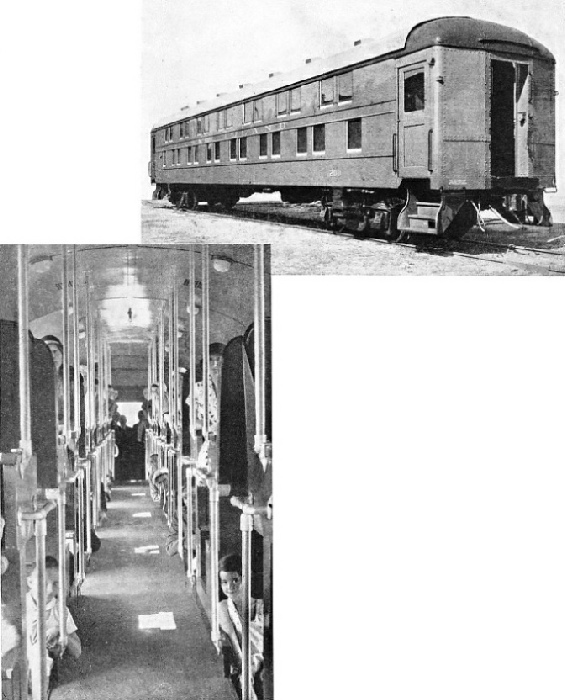
ONE HUNDRED AND TWENTY PASSENGERS can be carried in this double-deck coach, as compared with 76 in a car of the usual design and equal length. Both tiers of seats are built in pairs facing one another.
A DOUBLE-DECK COACH. The seats of the lower tiers have their floors fourteen inches below the centre gangway, and are reached by steps down. The seats of the upper tiers are placed above them and are reached by steps up. The coach was built at the Altoona Shops of the Pennsylvania Railroad, for operation on the Long Island Railroad between Pennsylvania Station, New York City, and suburban stations on Long Island. To ensure maximum comfort both in summer and winter, a special system of insulation has been installed, together with exhaust ventilators and a double roof; the roof provides free circulation of air between its two surfaces. Between the inner and outer walls of the car is insulating material. Heating and lighting are electrical.
In Great Britain, save in the matter of horse-boxes, carriage trucks, and wagons for conveying fish and other perishable consignments, and all such four-wheelers are barred from the principal express services, the four-wheeled passenger vehicle has practically disappeared. Six-wheeled coaches also are obsolescent, and few remain in Great Britain, except on the LNER. In America anything other than bogie suspension for either passenger or freight stock is virtually unknown, but on the Continent much four-wheeled and six-wheeled stock still remains Until comparatively recent years many of the French railways made use of four-wheeled coaches of immense length on main-line services.
The chief contribution to smoothness in modern railway travel has undoubtedly been made by the substitution of bogie suspension for the older rigid wheel arrangements. In the same way as that of the locomotive, the carriage bogie is a truck, supported on tour or six wheels, and in its turn carrying the end of the coach by means of a pivot. The bogies are therefore tree to swing, and thus to take smoothly and easily the curves in the track, the four or six wheels of the bogie truck take up the oscillations arising from slight inequalities in the track, and tend to damp them out before they reach the coach body. Bogie design has now become a fine art, and both steel springs and interposed rubber are brought into use so that the riding of the coach may be the smoothest possible.
For the support of dining and sleeping cars 65 ft 6-in in length or longer, the LMS Railway still uses the six-wheeled bogie, and it has become a widely-held idea that twelve wheels are necessary if the smoothest of travel is to be obtained. This is not, however, correct. All the standard stock of the LNE, Great Western, and Southern Railways is carried on four-wheeled bogies, without any sacrifice in the smoothness of riding. For some years the Great Western Railway built 70 ft coaches on eight wheels for main-line service. Similarly, much Continental stock, some of it considerably longer than British stock, is carried on eight wheels; and it is only in America, where coaches weighing from 75 to 85 “short” tons apiece are common, that six-wheeled bogies have become standard practice.
The advantages of carrying a coach on eight wheels instead of on twelve are obvious. There are two pairs of wheels and axles less to be provided for each vehicle; there are four axle-boxes less to maintain in service; and the weight of each bogie and of the coach as a whole is reduced.
Reference must now be made to the principle of coach articulation. It originated on the former Great Northern Railway, which had some corridor six-wheeled coaches that had not reached the end of their effective life, but were unsuitable for high-speed service. These coaches were, therefore, taken in pairs, and their wheels were removed; the outward end of each pair was mounted on a four-wheeled bogie, and the two inner ends on a massive steel casting, which in its turn was pivoted on a bogie truck. The two carriage bodies were now carried on three bogies in an indivisible unit of considerable length, which nevertheless was jointed in the centre, and enjoyed all the smoothness of riding of bogie stock.
The experiment was so successful that the principle has since been greatly extended. Many of the older non-corridor coaches of Great Northern type have been joined together in articulated sets of two, three, four, and five vehicles: twins, triplets, quadruplets, and quintuplets. For suburban service all the new LNER construction for a number of years past has been of articulated stock. On the Great Northern Section the suburban trains consist of quadruplets in pairs, making eight coaches in all; and on the Great Eastern Section of quintuplets in pairs, making ten coaches. During the slack midday hours the latter are divided, and one five-coaches articulated set forms a complete train.
Then there are the main-line articulated formations. In particular many triplet dining car sets are in use, on the “Flying Scotsman”, for example, consisting of a kitchen car in the centre, flanked by a first-class restaurant car at one end, and by a third-class carat the other. On the King’s Cross-Leeds service one complete quintuplet set is in use, with three restaurant cars, as in the triplets, and first-class and third-class brake coaches at the outer ends. Many twin sleeping cars are at work, some first-class throughout, and some composite first- and third-class cars. A large variety of twin main-line coaches, both corridor and non-corridor, also operates on the LNER.
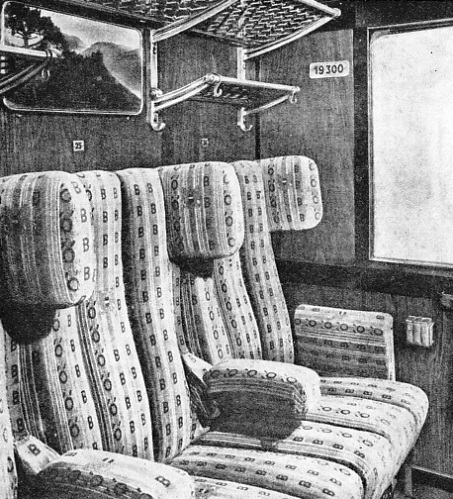
IN AUSTRIA. Spaciousness and modern railway comfort are typified by this second-class compartment in an Austrian Federal Railways eight-wheeled passenger coach. The Federal Railways possesses some 5,960 carriages; large numbers have been scrapped in recent years and replaced by modern stock of all-steel construction. It is estimated that recently about £950,000 have been spent on new passenger vehicles.
The advantage of articulation is twofold. There is a slight reduction in both length and weight in an articulated unit, as compared with ordinary independent coaches of the same capacity. Against this there must be set the disadvantage, a small one, it may be, but not negligible, that the articulated set is an indivisible unit, and it is not possible to take a coach out of it should less accommodation be required, or in the event of such a casualty as a “hot box”, which would entail the removal of the whole set from the train in which it was running.
Another contribution to smooth running is found in what is known as the “buck-eye” coupler. This originated in America, and is standardized on all American stock. In 1899 the then Great Northern Railway introduced it into England, and later fitted it to all vestibuled main-line stock. It is now-standard on all corridor coaches built for the LNE and Southern Railways. With the “buck-eye” coupler the coach-ends are bow-shaped and brought close together, and the usual coupling, with two links tightened by a screw, is replaced by two jointed steel “hands”, which engage automatically as the two coaches are pushed together.
In effect, the train which is entirely coupled in this manner becomes a jointed steel frame from end to end. Oscillation of coach-ends relatively to one another is minimized, and the coaches are in this way steadied and made to run more smoothly at speed. In the event of accidents, the dreaded telescoping of vehicles is made almost impossible, and this has been proved on not a few occasions when what might have been a disastrous derailment or collision has been turned into a minor mishap, because all the coaches of the train concerned have been held securely in line. Walking through the shortened vestibules between coaches is also more comfortable for passengers than with the normal square-ended coaches and long gangway connexions.
It is curious that European travel, generally in compartments, should differ so completely as it does from the almost invariable American plan of the open coach. But in recent years the LMS Railway has greatly extended the use of open cars in express trains in Great Britain. First built to provide supplementary restaurant car accommodation, these cars are often now incorporated in ordinary express trains. The modern excursion train is formed almost exclusively of open stock on the LMS, LNE, and Southern Railways. All the latest LNER open third-class cars are furnished with bucket seats, to reproduce as nearly as possible on rails the amenities of the modern motor-coach.
With the open coach there has come in the fashion of the end exits, not only in vehicles of this description, but in side corridor compartment coaches also. The costs of coach construction are reduced when end doors only have to be provided, as compared with doors to every compartment. The sole disadvantage is that ingress and egress are somewhat slowed down when the train stops, but with the comparatively lengthy stops of main-line trains this is a minor matter. End-door stock is universally used for main-line coach construction on the Continent and America, though side-door coaches are still needed by many railways for their suburban work.
A British Compromise
The vexed question of all-steel stock would need many pages of argument to be adequately discussed. Simply stated, the facts of the matter are that ultra-rigidity in railway coach design is not an unmixed blessing. The ideal is a vehicle which, while built with sufficient strength to prevent telescoping or crumpling under a severe shock, will nevertheless absorb and destroy a certain proportion of the momentum on impact. Otherwise the very rigidity of the coach may injure passengers in an accident almost as severely as the splintering or telescoping of a non-rigid coach. Experience has proved that the British plan of building coaches with strong steel underframes, wooden body-framing, and external steel plating, meets the need satisfactorily, as well as being an economical form of construction, and keeping the coach-weights within reasonable limits.
Coach lighting in all new British stock is exclusively electric. This has replaced the previous gas lighting, though numerous gas-lighted coaches still remain in service, just as gas in its turn replaced oil lamps. The electricity is generated by a dynamo under the coach, driven by a belt from one of the axles, and is stored during the day in large accumulators, so that light may be available when the carriage is standing as well as when it is running.
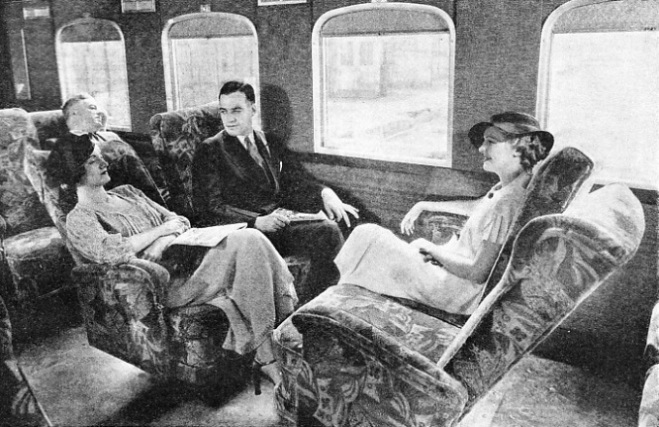
COMFORTABLE TRAVEL is the keynote of the American railway service. The above photograph shows the luxurious interior of a streamlined coach built at Milwaukee for the Chicago, Milwaukee, St Paul and Pacific Railroad in 1934. This company, operating some 11,000 miles, owns about 1,200 passenger coaches, including two completely streamlined trains for high-speed schedules.
On the LNER electric cooking is also standard in all new restaurant-car construction; this has several advantages, both in the cooking and in conducing to the comfort of the kitchen staff. It also provides an additional precaution against fire in the event of an accident, as no compressed gas in cylinders is carried beneath the restaurant car. The cars are provided with accumulators of extra large size, which are charged with current before the journey begins, and are supplemented on the way by dynamos driven from the axles, as in carriage lighting.
The LMS, also, is experimenting with electric cooking, but with a special Diesel-driven dynamo plant carried on the car to produce the current. On the Continent, however, the heating for kitchen ranges on restaurant cars is provided by small coke ranges.
This leads to a brief consideration of carriage warming in winter. For the most part this is provided by through steam-pipes from the locomotives, but on electrically operated lines a different system must prevail. The matter is simple on lines whose stock is confined entirely to the electrified routes, as electrical heaters are then provided. But for some years railways such as those of Switzerland, over which there run the coaches of many different countries in the through international trains, were in difficulties after electrification had taken place. It became necessary to run special boiler-wagons in the trains to provide steam heat. Now, however, the spread of electrification in Europe has been so great that the international stock is fitted for both steam and electric heating.
In countries where extremes of heat and cold are encountered the problem of cooling the cars in summer is as great as that of heating them in winter. This has led in the United States to the rapid spread of what is known as “air-conditioning”. With this system refrigerated air is injected into the cars in summer, and warm air in winter, so that an even temperature is maintained throughout the year. All the principal express trains of America are now “air-conditioned”.
Luxury accommodation is provided in Great Britain by the independent Pullman Car Company, which owns a large number of cars, both first-class and third-class, and pays a rental to the railway companies concerned for their inclusion in the trains. The Pullman Car Company then charges a small supplement to all passengers using the cars, and also derives revenue from the catering. The only trains composed exclusively of Pullman stock in Great Britain are the “Queen of Scots Pullman” and the “Yorkshire Pullman” on the LNER, and the “Brighton Belle” and the “Bournemouth Belle” on the Southern Railway. The “Brighton Belle” is claimed to be the only electrically-operated multiple-unit Pullman car train in the world. But the majority of the express trains between London and Margate, Ramsgate, Folkestone, Dover, Deal, Hastings, Eastbourne, Brighton, and Worthing carry Pullman cars in their formations. They are run, also, in the boat trains of the LNER to and from Parkeston Quay (Harwich), in those of the Southern to and from Southampton, Dover, and Folkestone, and on certain other services.
The Great Western Railway has built its own cars of a somewhat similar type for transatlantic boat expresses between Paddington and Plymouth. Among other luxury coaches are the open first-class lounge cars regularly-used on the “Merseyside Express” and the “Ulster Express” of the LMS, furnished with armchairs; the special coach of the LNER “Flying Scotsman”, which includes a cocktail bar and a hairdressing saloon; the cinema coach run daily on an LNER express from King’s Cross to Leeds and back with a full cinema programme daily; and the cars equipped for radio and gramophone programmes on the midday Scottish services between King’s Cross and Edinburgh.
On the mainland of Europe luxury travel is provided largely by the well-known Compagnie Internationale des Wagons-Lits et des Grands Express Europeens, or the International Sleeping Car Company, now allied with the famous travel firm of Thos. Cook and Son, Ltd, as the “Wagons-Lits-Cook”. The remarkable operations of this concern are described in the chapter beginning on page 1149, but a brief mention is necessary here to complete this survey.
Certain long-distance trains, such as the “Orient Express”, “Simplon-Orient Express”, “Rome Express”, “Blue Train”, and “Nord Express”, are composed exclusively of the sleeping cars of the Sleeping Car Company, with a restaurant car. All of them now admit second-class as well as first-class passengers. This independent company, which provides and staffs the cars and pays a rental to the railways concerned for the operation of the trains, collects the supplementary fares. The fares are higher in these luxury trains than when, as in many other services, the sleeping cars of the International Sleeping Car Company are included in the ordinary expresses. The company provides also the Pullman car services abroad, which in the majority of instances are made up into exclusively Pullman car trains. These include the “North Star” and “Blue Bird” between Paris, Brussels, and Amsterdam; the “Edelweiss Pullman”, between Amsterdam, Brussels, and Basle; the “Sud Express”, between Paris and Spain; and so on.
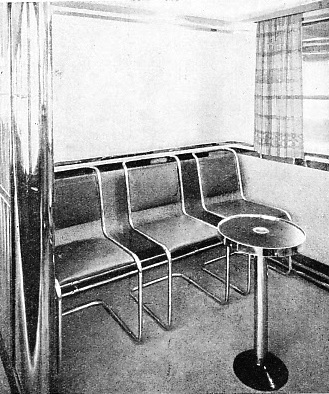
IN THE COCKTAIL BAR, which forms an attractive feature in one of the coaches of the famous “Flying Scotsman” express. This train, equipped with every device for modern luxury travel, has also a hairdressing salon.
Generally speaking, Continental rolling stock is considerably heavier than British. Ordinary corridor coaches turn the scale at anything from 35 to 45 tons, and restaurant and sleeping cars generally at about 54 tons. Pullman cars weigh from 48 to 54 tons, the variation depending on the presence or absence of a kitchen. The complicated mass of connexions provided on vehicles intended for the international services is explained by the fact that provision must be made for different systems of braking in all countries through which the coaches will pass, together with steam-heating and electrical heating connexions, and so on.
As to the accommodation, second class on the Continent generally corresponds to third class in Great Britain, and Continental third class, often bare boards, provides a third alternative at a considerably lower rate per mile. Many Continental trains carry second-and third-class accommodation only, and in countries such as Norway first class is provided only on the international trains. In France and Germany, on the other hand, the fastest trains are confined to first- and second-class travellers only.
To the Englishman, accustomed as he is to the simplicity of two classes of travel, save for the supplements charged for sleeping or Pullman cars on the relatively few trains carrying such vehicles, the accommodation offered him on the American continent may well seem almost bewildering in its variety. He takes his American “folder”, the equivalent of a British time-table, and finds specified in it the precise composition of the train by which he hopes to travel. He reads of such hitherto unheard-of vehicles as “Standard Sleeper 8-Section 1 Drawing Room 2 Compartments”, “Observation-Cafe-Parlor Car”, “Broiler Buffet”, “Tourist Sleeper”, and many other varied designations of rolling stock.
Or, against some express of particular note, he may observe the legend “No Coaches”, suggesting to his mind, no doubt, some species of “ghost train”. Here it should be explained that the “coach” rate represents the basic charge for American railway travel, somewhat corresponding to third-class fare in Great Britain. To this there are added the various supplements for more luxurious descriptions of travel, chiefly in Pullman cars, so that a train conveying “no coaches” is one made up exclusively of Pullman accommodation, which cannot be boarded without the payment of a supplement.
In America “coach” accommodation is exclusively in open cars, sometimes called “Day Coaches”, and seating two passengers on either side of a central aisle, the more ample loading gauge of American railways making the extra width possible. A typical vehicle of this type, some 70 feet long, and carried, as generally happens, on six-wheeled bogies, provides seating for seventy-two people, and has, in addition, a small smoking compartment, as smoking is not permitted in the main saloon, and lavatories at either end. The “Parlor Car”, however, corresponds to a British Pullman car, and is provided with armchairs, usually arranged to swing in any direction, down either side of a car that is also completely open from end to end, save for the same smoking and lavatory accommodation as in a “coach”. “Parlor cars” are normally attached during day-time runs only, and command a small supplement over the “coach rate”.
American “Standard Sleepers”
Restaurant cars in considerable variety are included in the day trains. Where custom warrants it, a full-size car, seated with chairs and tables as in a restaurant, and having the kitchen at one end, is attached, sometimes only during meal hours. On other trains a variety of buffet cars are used. A “Broiler Buffet” indicates a buffet with facilities for cooking a steak or chop; a “Buffet-Parlor Car” is an open Pullman car with a buffet at one end; an “Observation-Cafe-Parlor Car” combines both the latter with an observation rear end to the car.
Observation cars are a feature of American travel. Attached to the rear end of important trains, the original open platform outside has now for the most part been abandoned in favour of a curved “tail”, consisting chiefly of glass, and with the chairs so arranged in the end of the car as to command a good view of the track and the scenery disappearing behind the train. There is one example of this type of car in Great Britain in the “Maid of Morven”, a one-time Pullman car now taken over by the LMS. From June to September inclusive this car travels over the picturesque line between Glasgow, Callander, and Oban in Scotland.
Then comes the lengthy and varied range of American sleeping car equipment, of which the commonest form is the “Standard Sleeper”. On long journeys across America and Canada, it is necessary to provide the passenger with comfortable seating accommodation by day, and with reasonably comfortable sleeping quarters by night. The same vehicle is therefore made to serve either purpose, similarly to the couchette in France, and to the earlier third-class sleeping cars in Great Britain.
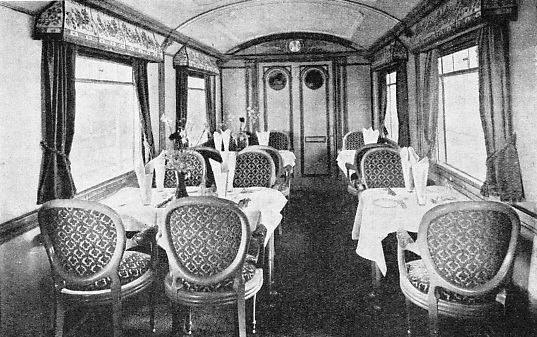
THE “FLYING SCOTSMAN” includes superb restaurant cars in its make-up. Triple articulated restaurant car sets measuring 151 ft and weighing, when complete, over 80 tons, are used on this British express.
In both the two types of car last-mentioned, the seats are used to provide berths at night, and additional berths are provided above by letting down the upper side walls of the compartment, so that the compartment provides four berths in all. But in American “standard sleepers” the berths are arranged longitudinally and not transversely. The seats of each “bay” of the car are pulled out until they meet across the leg space; and the two sides of the car roof, on either side of the central clerestory, are then lowered to provide continuous upper berthing from one end of the car to the other. On either side of the central gangway curtains are then drawn, and passengers have to perform the acrobatic feat of removing their clothes and preparing for the night while in their berths behind the curtains.
Each “bay”, or pair of seats in the car, is known as a “section”, and there are therefore two rows of “sections”, one on either side of the aisle. Each “section” seats four persons in the day-time, and the corresponding berths can at night, if necessary, accommodate four, two in each “double bed”. It is not, however, customary at night to carry more than two persons in each “section”, one in the upper and one in the lower berth; and similarly on the opposite side of the gangway. The usual smoking-room is provided in the car, together with a “wash-room”, provided with several wash-basins and of necessity used by all the passengers in the car, and lavatories. Most of these cars contain also a “Drawing Room”, which is a compartment shut off from the rest of the car, and containing what is in effect a complete “section”, with, in addition, a sofa berth and a separate lavatory; this will house three persons in comfort, and six if necessary. The difference between the “drawing room” and the rest of the car is that the supplement for the “room” must be paid as a whole, irrespective of the number of persons using it, whereas the supplements for the use of “sections” of the car are per berth, and vary for the use of upper and lower berths respectively.
Transcontinental Accommodation
It is also possible for a single passenger to engage a complete “section” to himself, termed a “bed section”, without the upper berth being made up, at an appropriately higher charge. The attendant who has charge of the car is known as the “porter”; he does all the work of preparing the car at night and restoring it for day use the next morning. He makes all the beds up with sheets and blankets, and does everything necessary for comfort.
It may be argued that sleeping accommodation of this description, while superior to that of the British third-class sleeping car, falls considerably short of the comfort of British first-class cars. But on most of the important American services compartment sleeping cars are now provided, with beds and self-contained lavatory equipment, which are fully the equal in luxury of the best in Great Britain.
Then there are combinations of the various types of sleeping accommodation, some cars containing within the length of one vehicle a number of standard “sections”, a “drawing room”, some separate sleeping compartments, a smoking-room for men, and a ladies’ dressing-room. There are also cars somewhat resembling the Continental sleeping cars, with separate sleeping compartments which in the day-time are converted into comfortable day compartments after the British pattern. For each different type of accommodation a varying charge is made, from the modest rate for a lower sleeping berth in a section up to the heavy charge for a separate "room."
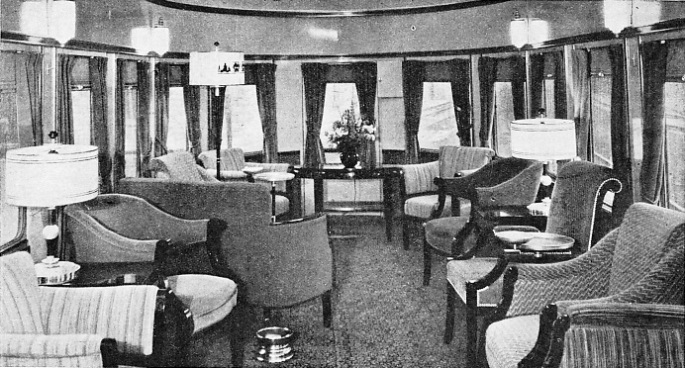
A DRAWING ROOM ON WHEELS is the effect of this handsomely furnished observation lounge on the rear of the Baltimore and Ohio Railroad’s new streamlined express, the “Abraham Lincoln”, operating between Chicago and St. Louis. The express covers the 284 miles run in 5½ hours. The company, controlling some 5,550 miles, owns about 1,680 passenger coaches.
On the long transcontinental journeys, particularly in Canada, somewhat simpler sleeping accommodation is provided in what are known as “Tourist Sleepers”, the supplement for which is about one-half the standard sleeper rates. A typical “tourist sleeper” has fourteen “sections”, made up at night into comfortable upper and lower longitudinal sleeping berths, and also provided with men’s and women’s wash-rooms, and a kitchen. The kitchen has a range on which those who so desire may cook their own meals, and so economize on the cost of dining car service.
On a still lower scale are the “Colonist Cars” provided for settlers; there are nine bays in each of these cars, seating seventy-two people, which are prepared for the night in the same way as the standard sleepers; passengers must provide their own bedding. A kitchen is also included in the equipment, as in the tourist cars. But the cost of travel in “colonist cars” is less than the standard rate for “coaches”.
The latest development of the observation car is the “Solarium Lounge Car”, with deep “Vita Glass” windows, a large open observation room furnished with armchairs, library, smoking-room, ladies’ lounge, shower-bath compartments, and buffet service. A “Compartment Observation Car” includes observation lounge, library, three sleeping compartments and a “drawing room”, and buffet service, being thus a self-contained luxury coach for both day and night use. There is also the “Club Compartment Car”, with “drawing room”, four sleeping compartments, lounge room, and buffet service. The list might be continued indefinitely. The barber’s shop is a general feature of the equipment on long-distance trains, as are also shower-bath compartments. A valet, lady’s maid, and stenographer are often included in the train staff. One of the famous expresses between New York and the Florida coast goes to the length of including a car which contains a small swimming pool.
The composition of an American passenger train is completed with various descriptions of baggage cars, in which also a good deal of space is reserved for the United States mail and staff. On long-distance trains a “Combination Baggage Car” is provided, with a portion partitioned off to furnish sleeping quarters and a rest-room for the restaurant car staff.
A Canadian Express
A typical train formation for a transcontinental express is that of the “Dominion Express” of the Canadian Pacific Railway, from Montreal to Vancouver. This is advertised to include “coaches” throughout from both Montreal and Toronto to Vancouver; “colonist cars” from Toronto to Winnipeg and from Winnipeg to Vancouver; a “tourist sleeper” of fourteen “sections” - from Toronto to Vancouver and another in connexion from Montreal to Winnipeg; “solarium-parlor” and “cafe-parlor” cars from Montreal to Ottawa only; a sleeping car (eight “sections”, two compartments and “drawing room”) from Montreal to Vancouver, and a similar car from Toronto to Winnipeg. There are also “standard sleepers” of twelve “sections” and a “drawing room” from Montreal to Sudbury, from Toronto to Vancouver, and from Winnipeg to Vancouver; and an observation car with lounge, three sleeping compartments, and a “drawing room” from Toronto to Vancouver. In addition, dining cars are provided on the Toronto-Fort William, Kenora-Swift Current, and Medicine Hat-Vancouver stages of the journey.
Yet another detail of equipment is an entirely open observation car, attached on part of the journey. Further sleeping cars are added to the formation of the train as required.
For staffing the train, apart from engineer (or driver) and fireman, there is a conductor, or head guard, with trainmen to assist him; a sleeping car conductor in charge of all the sleepers, and one “porter” to each car; a “parlor car attendant” for each car of this description, and the dining car staff. A train of this description is thus in every way a hotel on wheels, and is occupied by through passengers, making the entire journey from Toronto or Montreal to Vancouver, for no fewer than three and a half days.
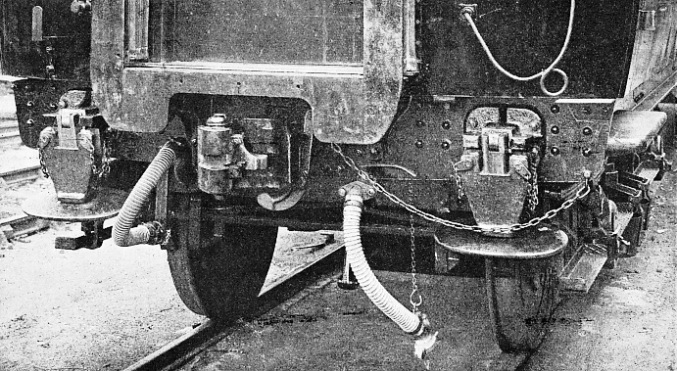
AUTOMATIC COUPLING GEAR, known as the “buck-eye” - a type of American origin - has been widely introduced on British railways, and makes for additional safety and smoother running. The jaw of the coupler, ready to engage its fellow on the next coach, can be observed between the two side buffers, which have been dropped down in readiness.
You can read more on “The North American Railway Carriage”, “The Railway Carriage” and “Rolling Stock Construction” on this website.











